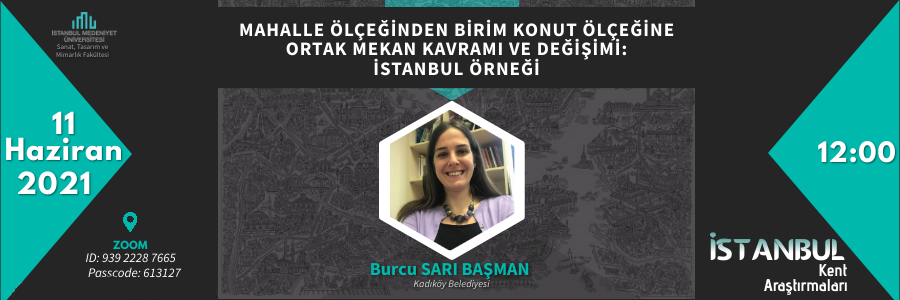The 9th seminar of the “Istanbul Urban Studies” seminar series organized by the Department of Urban and Regional Planning of Istanbul Medeniyet University was held online on June 11, 2021. The seminar moderated by our Urban and Regional Planning Department member Dr. Ayşegül CAN hosted Urban Planner Burcu SARI BAŞMAN, MSc. from Kadıköy Municipality, who delivered a presentation titled “The Concept of Common Space and its Changes from the Scale of Neighborhood to the Housing Unit: The Case of Istanbul”.
BAŞMAN started her presentation with concepts like belonging, space and place and evaluated the common space phenomenon for three time periods (before 1950, 1950-1980 and after 1980) in three different scales including ‘housing unit’, ‘lot- housing parcel-street’ and ‘neighborhood unit’. She characterized pre-1950’s with traditional and single-family housing which was pedestrian-friendly and had common space in street-scale. She defined the common spaces of that era as squares, gardens and courtyards. On the other hand, BAŞMAN mentioned that the 1950-1980 period was a transition from traditional housing to apartment buildings resulting from population increase and industrialization, when the street was no longer a common space creating a sense of belonging. She described the housing structure and urban texture of post-1980s with private and gated housing areas disregarding city life, street culture and common space.
BAŞMAN analyzed the change and transformation of common spaces in Levent, Ortabayır and Esentepe neighborhoods from Istanbul for 3 scales and 3 different time periods. She used parameters like accessibility, design, security, continuity, diversity and boundary to evaluate the neighborhoods. As a result of her study, she stated that Levent was a successful example whereas Ortabayır can be characterized with unplanned common spaces. She further explained that Esentepe had isolated, disconnected and fee-paying areas far from being common spaces.
The q/a part that followed was quite enlightening and comprehensive in terms of the variety of questions. Firstly, better planning options for common places in Istanbul was discussed. Then, it was questioned whether gated communities can be marked as well-designed or not in terms of BAŞMAN’s parameters. The possible relation between land rent and common places was also discussed. It was further discussed whether the physical qualifications of common spaces are in accordance with the laws and regulations. Finally, BAŞMAN clarified the effects of increasing development rights on the sufficiency of common places in Kadıköy.
.png?w=843&ssl=1)

